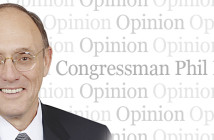By Jeff Keeling
While my 4-year-old grandson is stretching his mind toward a grasp of ever-larger numbers, his congressman is trying to help shave a few digits off of the federal debt he will inherit in adulthood. And while Owen is instructed and encouraged to put others before himself in his interpersonal interactions, his congressman is playing nice with folks from across the aisle.
So on both those counts, Phil Roe, thank you: for a substantive legislative achievement and for setting an example of working with others that, during this Holy Week, is worthy of emulation for all of us little children, be we 4 or 84.
Owen, who will start kindergarten in August, is into big numbers these days. As we read stories from our wonderful Beatrix Potter anthology, he enjoys pointing to the bottom of a page and announcing the number there, particularly if it’s got three digits. This phase has been part of a broader fresh interest in learning – from pointing out locations on his world map to sounding out small words – that has come as a welcome relief to the adults in his life after a period of relative disinterest in book learnin’.
His Pop Pop (that’s me) loves numbers, so when Roe got into the weeds last week about Medicare spending and reimbursement models, I was right there with him. And for someone who wrote a letter to Congress “from” an in-utero Owen five years ago pleading for a fix to unsustainable entitlement spending, hearing Roe describe his work on a proposed law that would stabilize Medicare spending (see page 1) was like listening to sweet music.
As both a symbol and reality of a wealthy society’s commitment to looking out for its older citizens, Medicare is a terrific program. But it hasn’t been on an actuarially sound path as health care costs outpace inflation and the ratio of beneficiaries to working-age Americans skews further and further as our population ages. Estimates show net outlays on Medicare rising from $512,000,000,000 in 2014 to $858,000,000,000 in 2024. Owen isn’t the only one who might have difficulty keeping track of the zeroes in those numbers.
Everyone in Congress has known this for years. Aside from some tinkering around the edges, though, progress to address it has been hampered by hyper-partisanship and a fear of alienating the all-powerful senior voting bloc. I’m hopeful that started to change with the crafting and passage of House Resolution 2.
Why I am hopeful? Well, for one thing, Roe said this: “Without Pelosi pushing back against the Senate, this never would have passed.” Yes, that was Phil Roe, representing this deep-red Congressional district, praising Nancy Pelosi, poster child of the left and architect of the Affordable Care Act’s partisan cramdown.
Roe agreed that increasing some premium costs on higher-income seniors was a stretch for a GOP that has been adamant in its overall refusal to increase revenues in any way. On the other hand, “the Democrats just accepted changes in Medicare,” he said. The bill contained additional compromises designed to please members of both parties, and it passed 392-37.
“If the Affordable Care Act had been done this way,” Roe told me, “you wouldn’t have this disconnect now, this push back, because half of Congress was left out of it.”
Roe hopes to be involved in further steps to set Medicare on a path to what he called “true reform.” I’m hopeful to see that, and see it done in a way that doesn’t leave half of Congress out of it. After all, how can we expect success in teaching our pre-schoolers to bridge their differences when things get chippy around the toy box if we can’t expect reasonable compromise from our highest elected leaders when our nation’s long-term challenges desperately need to be addressed?




